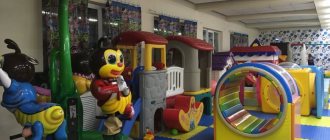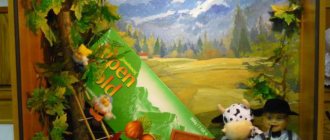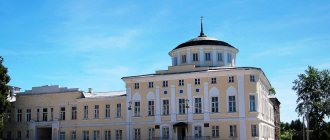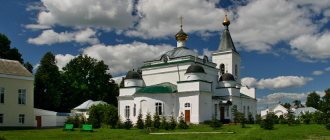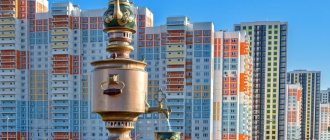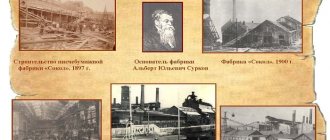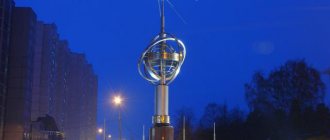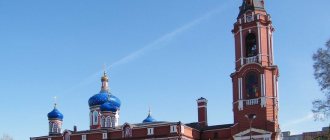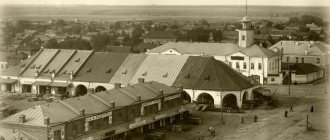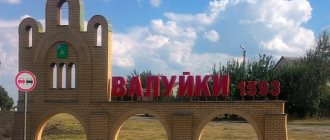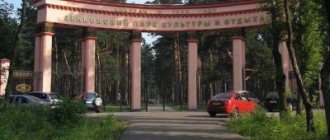In the Vladimir region there is a quiet and cozy place, included in the Golden Ring of Russia - the village of Bogolyubovo. The seemingly unremarkable territory contains many monuments of spiritual heritage and pleases the eye with incredibly beautiful landscapes.
People come here to recharge with positive emotions and learn a lot of interesting things about how our ancestors lived. The province of the Suzdal region, located on the coast of Klyazma, delights tourists with its special atmosphere. The village was once the residence of Andrei Bogolyubsky. After some time, a monastery appeared on the territory.
There are few attractions, the village is small. All sites are included in the UNESCO World Heritage List. Monuments of white stone architecture of the 12th century predominate. In summer there are many places for organizing outdoor recreation. The area is not crowded, so peace and quiet are guaranteed. You will definitely want to swim in Klyazma. The water is clean and clear. There are specially equipped sandy beaches on the territory of the village.
History of the settlement
The settlement was founded in 1158 by Prince Andrei Bogolyubsky. Under Prince Andrei, Bogolyubovo became a city with a permanent population, self-government, trade and crafts. At that time it served as the residence of the ruler. In those distant times, Rus' was very turbulent: wars and strife reigned all around. And in the midst of all this turmoil, Bogolyubovo was an island of calm and silence.
For seven years, construction work was actively carried out here: a church, a cathedral, a palace, and defensive structures were erected. It is interesting that stone was immediately used as a building material, while in other cities the first buildings of that time were predominantly wooden. Gradually, a fairly large settlement formed around the palace, which acquired permanent residents, local government, a settlement, and a militia. Trade and crafts actively developed here. As a result, the settlement received the de facto status of the capital of North-Eastern Rus'.
According to historical research, in the period before the Tatar-Mongol invasion, the settlement was surrounded by a double fortification (the inner contour was stone, the outer contour was wooden), inside of which the white-stone palace of Prince Andrei was located.
After the death of the Vladimir prince, development abruptly stopped. In 1177, the city was attacked and plundered by the Ryazan prince, as a result of which it suffered greatly. A century later, the defensive structures were destroyed as a result of the Mongol-Tatar invasion. In such conditions, the city could not develop successfully and lost its former significance. In the 17th-19th centuries, temple construction was actively carried out in the central part. The Bolsheviks who came to power closed the monastery in 1917. He returned to life only in the early 90s.
Despite all the hardships that befell it, the village has not lost its historical value, which only increases over time. The ditches, earthen ramparts, dilapidated white stone fortifications, the castle, the Church of the Nativity of the Virgin Mary (its basement part) and much more have been partially preserved to this day.
A little about the town
The ancient areas in Bogolyubovo are not affected by modern buildings. Therefore, director Tarkovsky gave the village the honor of playing the main role of a medieval village in his film. According to the cameramen, the panorama of the area has retained its medieval beauty.
However, the village of Bogolyubovo is extraordinary. A completely different town neighbors the ancient city - one-story log buildings with sheds, outbuildings, vegetable gardens and a population of just over four thousand. Life in it proceeds the same way as in any Russian outback. Most of the residential buildings in the village of Bogolyubovo are ancient, built at the beginning of the last century. The walls of the houses, although wooden, are so strong that it is impossible to drive a nail.
Attractions
The greatest value from a historical and architectural point of view is the Holy Bogolyubsky Convent, which was once part of the palace complex of Andrei Bogolyubsky. The building was erected on the site of the prince's chambers after his death as a symbol of atonement for sins. Today the monastery complex is considered the largest in central Russia. The slender architectural ensemble gives aesthetic pleasure, and the sculptural portrait of Prince Andrei, recreated from ancient casts and drawings, is of particular historical interest.
The Church of the Intercession on the Nerl deserves special attention, which is not only a striking landmark of Bogolyubov, but is also a true pearl of the Vladimir-Suzdal Nature Reserve, which includes the settlement. Tourists will also be interested in the palace of Prince Andrei Bogolyubsky, Bogolyubovsky Meadow, the railway station and other attractions of the city.
The first day
So, you have arrived in Vladimir, it’s early morning and you don’t know where to start. First of all, drink coffee in one of the cafes on Bolshaya Moskovskaya Street and be sure to choose one that has its own pastries, and then go sightseeing.
Golden Gate, photo Arthur Lookyanov
The calling card of the city is, of course, the Golden Gate. The two remaining white stone columns are located next to the old city ramparts and, alas, no longer sparkle with gold. However, despite the legends, there was no precious metal on them - there was only sheet copper. This pre-Mongol architectural monument never fails to attract tourists, so don't be surprised if you have to wait a bit for your turn for a photo shoot.
Vladimir, photo by Arthur Lookyanov
Then it’s worth going on the longest tour of Vladimir’s churches. Whether you are interested in ancient frescoes and icons or not, it is worth seeing the Assumption Cathedral, the Chambers and the Trinity Church at least from the outside. However, almost all the churches and monasteries in the city can boast of a rich history, so all you have to do is wander around the city and admire it.
Babusi-Yagusi Museum in Vladimir
In the afternoon, you can have fun and visit one of the small museums, for example, the Babushi-Yagushi Museum with a fairy-tale hut on chicken legs and a full set of witchcraft equipment, or a real forge, where you can forge a nail for yourself under the guidance of professionals.
You can end the day at the “At the Golden Gate” restaurant, where they serve delicious dishes on coals and prepare their own mead.
Palace and chambers of Prince Andrei Bogolyubsky
The chambers of the Grand Duke of Vladimir are a unique architectural monument of the 12th century.
Unfortunately, the palace has not been preserved, with the exception of only part of the buildings. The complex was built almost simultaneously with the Church of the Nativity of the Virgin. These are the first buildings that appeared on the banks of the Nerl River.
The Palace of Prince Bogolyubsky is the only civil building of pre-Mongol Rus' that has survived to this day and has been preserved at least partially.
The only fragments of the castle that have survived to this day are the gallery and the staircase tower, which became the site of the death of Andrei Bogolyubsky.
The prince spent 17 years in his country residence. Here in the summer of 1174 he was killed by his political opponents, the boyars Kuchkovich. The conspirators quietly snuck into the prince's bedroom and began beating him while he was sleeping. The traitorous servant stole the sword that was lying under the owner’s pillow in advance, which is why Andrei Bogolyubsky could not fight off his opponents. Deciding that the victim was finished, the conspirators left the crime scene. The prince remained alive, but at the moment when he was going down the stairs, he was noticed by a servant and thrown into the weeds.
Palace and chambers of Prince Andrei Bogolyubsky
The castle was considered lost for a long time. The fact that the princely chambers were located here became known by chance. In 1954, archaeologist N.N. Voronin discovered a spiral staircase that led to the tower, as well as a dilapidated passage to the Church of the Nativity of the Virgin. The temple formed a single complex with the castle, but now only the basement part remains of it.
The majestic beauty of the princely chambers can only be judged by ancient drawings and records. Thanks to N. Voronin's many years of work, the appearance of the princely castle ceased to be a secret. According to research, the princely palace was a two-story majestic building made of white stone, decorated with decorative carvings.
The palace was located on the banks of the Klyazma River, in the southern part of the city. From this place there was a wonderful view of the mouth of the Nerl River, which flowed into the Klyazma, nearby forests and the beauty of endless fields.
In addition to the palace and temple, the architectural ensemble included a stone ciborium and defensive walls. Palace buildings stretched in small groups around the square. The princely chambers were connected to the temple by arched passages with towers. Inside the latter there were spiral staircases, along which the prince, together with his entourage, could go directly to the church choir.
The cathedral, also built of white stone, was decorated with carved reliefs, copper tiles decorated with gilding, and stained glass windows. On the temple square there was a “holy tent” with the faces of the Mother of God, under which stood a bowl intended to consecrate water in memory of the appearance of the image of the Mother of God to the prince. The palace ensemble was surrounded by high (up to 6 meters) earthen ramparts, on which stood white stone walls and watchtowers.
Now the place of Andrei Bogolyubsky’s death is decorated with paintings depicting this terrible event. After the death of the prince, the palace was plundered, and at the beginning of the 13th century a monastery settled here. When, at the direction of the abbot, work began on expanding the windows of the temple, the monastery vaults could not stand it and collapsed. After some time, a new temple was founded on this site, and the two-tier tower with a gallery has since been part of the Bogolyubov Monastery. At the moment, a niche has been installed here in honor of Prince Andrei Bogolyubsky, who was canonized in the 18th century. In a niche there is a stone chair on which there are always fresh flowers.
Place of murder of Andrei Bogolyubsky
Address: st. Lenina, 51, territory of the Bogolyubsky convent.
Detailed information about this place can be found on the website of the Vladimir-Suzdal Museum-Reserve
Where to go with a child in Vladimir
Guidebooks will tell you what sights to see in one day in Vladimir with children, not only to learn about the history of the city, but also to have fun.
Tourists with children (7-14 years old) will be interested in visiting such attractions as:
- fairytale museum “Granny-Yagusya” on B. Moskovskaya Street 26, where grandmothers from all over the world are collected. Here you can not only learn about this ancient image, but also have fun dancing and be a little scared.
- The Gingerbread Museum, which will offer an interesting program. Here, the organizers conduct gingerbread-painting master classes and serve gingerbread, tea and pancakes. Here you can buy souvenirs.
- The Eureka Museum of Science and Man, which is located on B. Moskovskaya Street 11. Here you can not only learn some interesting points about light, sound and mechanics, but also take part in experiments. The organizers of the show with nitrogen and ice cream are conducting an interesting show. Neither children nor their parents will be bored.
- Dali Museum 33, where you can not only see unusual exhibits, but also take part in amazing quests. Museum address: B. Moskovskaya 22.
- Museum Old Vladimir (Kozlov Val street 14), which contains:
- antiques;
- things;
- newspapers;
- ads;
- clothes from tsarist times.
At the very top of the 4-story tower there is an observation deck, which offers views of many of the sights of Vladimir.
Tourists with children are recommended to visit 2-4 interesting places in the city of Vladimir during the day, no more. Otherwise, all the attractions will simply tire both of them.
It is better to plan a children's excursion around the city so that after visiting 2-3 historical places you can take a short break. During it, you can go to lunch at the nearest cafe, restaurant or relax in any park in the city.
For example, after visiting the Old Vladimir Museum and the Dali Museum 33 in the morning, you can relax in the Patriarchal Garden and have lunch at the Pancakes cafe (66 Spasskaya St.). You can spend the afternoon having fun at the Babusya-Yagusya Museum and the Gingerbread Museum. There will be more than enough impressions.
Bogolyubovsky meadow
The attraction is a protected area of the city, in the center of which is the Church of the Intercession on the Nerl. The study of the territory began not so long ago - in the 60s of the 20th century. During research, three hundred rare species of rare flora were found here, some of which are listed in the Red Book.
Bogolyubsky Meadow often becomes a place for walks, but it is not always accessible for these purposes: during high water the area is heavily flooded, so you can only overcome the space by swimming. In such cases, it is suggested to rent a boat.
Bogolyubovsky meadow
Tourists and city residents can use two routes:
- Expensive for pedestrians. The path is paved with tiles, and along it there are souvenir shops. The path starts from the railway station.
- Ecological path. You can walk along it in spring and summer: this is when excursions are held here.
What a tourist needs to know
Vladimir is a regional center with a population of about 350 thousand, adjacent to the Moscow region and was once the capital of Russia. But today it is a real province with everything that comes with this concept. Residents of the capital will be pleased with the clean air and the complete absence of traffic jams; there will always be a place to park. But if you can’t travel in your own car, don’t worry. In Vladimir it is not needed. The city is located on the picturesque bank of the Klyazma, and its quiet streets are so calm that it is better to walk along them on foot to fully enjoy the beautiful architecture and nature.
You can stay in one of three large hotels or in a small hostel. If you want to save money, rent an apartment for a day a little further from the center, but it doesn’t matter - Vladimir is small, if you can’t get somewhere on foot, you can call a taxi and for 100-200 rubles they will take you anywhere. Otherwise, prices are quite high, aimed at tourists. Keep this in mind if you decide to drink coffee on one of the terraces in the center
To get here you can take a plane, train or bus. The airport is located a couple of kilometers from the city and is used mainly by military aircraft or helicopters of the Ministry of Emergency Situations. Public planes arrive here mainly from St. Petersburg; you will have to take a taxi to get to the city. The most convenient way to get from Moscow is by bus. They depart every hour and a half, the journey will take up to three hours with short pauses along the way. It will be faster on the Lastochka - you will be there in an hour and forty minutes. Trains and buses also run from other cities to Vladimir - every day the local railway and bus station handles dozens of transport units from all directions, so there will be no problems.
Bogolyubovo railway station
The station is located on the railway line connecting Moscow and Nizhny Novgorod, 10 kilometers from Vladimir. An old fence stretches around it. It is surprising that the wooden building is still heated by a stove. The appearance of the station has remained virtually unchanged since its inception.
Bogolyubovo railway station
Church of the Intercession on the Nerl
Date of construction: 1165. The temple is located at the confluence of the Nerl River and Klyazma. The hill on which the building rises is embanked. Around it stretch meadows, which are filled with the waters of the Nerl River every spring. For this reason, excursions to the temple are most often held in summer and autumn.
The building was erected quite quickly - in just one summer. The height of the church is about 21 meters.
There are several theories about what was the idea behind the construction of the temple. According to the first of them, the church was dedicated to the deceased son of Andrei Bogolyubsky, Izyaslav.
The second theory says that the temple was erected in honor of the prince’s victorious battles with the troops of Volga Bulgaria. The materials for construction were stones brought from enemy soil. It is generally accepted that this church was the first dedicated to the Feast of the Intercession of the Blessed Virgin Mary.
Church of the Intercession on the Nerl
In the 13th century, attempts were made to destroy the building in order to build a bell tower. However, the work stopped before it began. On the very first day, one of the craftsmen almost went blind: a grin got into his eye, and in order to restore his sight, the builder began to pray, his tireless requests lasting for many hours in a row. The ability to see returned to the master, and this miracle saved the church from destruction.
The beauty of the structure has been preserved to this day. You can observe it in the ancient stone decor in the form of lions and griffins, symbolizing princely power. In the exterior design of the building, among many drawings, you can see the image of King David. There is also a mask of the Virgin Mary. As for the interior, of all the decorations, only the carved altar has been preserved. Unfortunately, the 13th century frescoes did not stand the test of time and literally turned to dust.
Antique stone church decor
The water meadows for which the village is famous are part of the protected area.
The walls of the church conceal a mysterious spirit of antiquity, thanks to which interest in the architectural monument never fades.
Address: st. Vokzalnaya, 10. You can get from the village to the church on foot from the railway station (it’s not far, only 2 km). Another option is to travel by horse-drawn carriage or by boat (during high water).
Murom museums
The ancient Russian city will delight tourists not only with an abundance of architectural delights and monuments. Among the places where experienced travelers advise to go in Murom, one cannot help but mention interesting museums.
Historical and Art Museum
The doors of the local history museum first opened to visitors on January 1, 1919. Today, the institution’s funds include more than 95 thousand items. The collection of ancient Russian art is of particular value. Exhibitions of artifacts found by archaeologists during excavations in Murom and its environs are of constant interest to visitors. Among the exhibits you can see such rarities as matchlock and flintlock guns of the 17th century, and armor of Russian knights. A separate section of the exhibition is dedicated to the flora and fauna of the Murom land.
Art Gallery
Part of the IHM exhibition is shown in the halls of the mansion once occupied by the City Duma. Collections of Western European and Russian art of the 17th–19th centuries are exhibited here. In addition to paintings, engravings and sculptures, visitors will be able to view a collection of antique porcelain, Empire bronze, and antique furniture made by German masters of the 18th century. The gallery has a magnificent collection of antique clocks, candlesticks, candelabra, and Italian majolica.
Cyber Museum
Museum visitors are invited to take a retrospective journey through the world of cybernetics. The exhibition presents a variety of computer models - from the IBM-286, produced in 1981, to portable laptops. Today's schoolchildren will be able to get acquainted with the predecessors of USB drives - floppy disks, tape cassettes, reels, video equipment, which have long been replaced by modern electronic devices. The museum has a chic collection of rotary phones and cameras. Guests are offered to take a fascinating interactive tour of Murom using 3D glasses.
Church of Joachim and Anna in Bogolyubovo
Construction of the temple was completed in 1857. If at first the building was located in the city center, now it stands near the Maskva-Ufa highway. It was no coincidence that the church received its name - Joachim was the father of the Virgin Mary, Anna was the mother. Construction lasted an unusually long time - as much as 50 years. In 1939 the church was closed, and soon it was completely destroyed. However, most of the building still survived: during the Soviet period it housed a cinema, then a warehouse and a store. In the 90s, when atheism ceased to be part of the state ideology, restoration work began, which, due to lack of funding, continues to this day.
Church of Joachim and Anna in Bogolyubovo
The Church of Joachim and Anna is often visited by married couples who pray for children.
Address: st. Lenina, 48. Opening hours: Monday – Sunday from 8:00 to 18:00.
Historical places and museums of the Vladimir region
Alexandrovskaya Sloboda
Alexandrovskaya Sloboda is an ancient Russian fortress that served as the residence of Ivan the Terrible from 1564 to 1581. The Alexander Kremlin was at that time the center of domestic and foreign political life; the embassies of England, Sweden, Crimea, the Grand Duchy of Lithuania, Denmark and other states were received here.
The Kremlin is one of the most significant architectural monuments in the region.
In addition to the well-preserved and restored fortifications, here you can see:
- white stone Assumption Monastery;
- Trinity Cathedral;
- Crucifixion Church-bell tower;
- Marfin Chambers;
- the Church of Fyodor Stratelates rising above the gates of the Kremlin.
Khrapovitsky Estate
“Muromtsevo” is a noble estate of the late 19th century. It was built for Vladimir Khrapovitsky, Colonel of the Life Guards. The mansion itself, parks and office premises occupy more than 40 hectares.
According to local legend, the appearance of the mansion is due to a dispute. The future owner once said during a trip that he could build a palace in the Russian province that would be as good as the European ones. As a result, a manor in the Gothic style, fashionable for that time, appeared in the surrounding forests.
Maltsov Crystal Museum
Address: Gus-Khrustalny, st. Kalinina, 2aPhone: 8 (49241) 2-19-30 Opening hours: 10:00 – 17:00 Mon-Sun Cost: 200 rub. (adult)/120 rub. (children)
The museum contains a collection of products produced by the Gusev Crystal Factory from the second half of the 18th century, totaling more than two thousand.
The building itself, where the exhibition is located, was built in 1903 as the Cathedral of St. George the Victorious.
Memorial House-Museum of N. E. Zhukovsky
The famous Russian scientist N. E. Zhukovsky lived and worked in the village of Orekhovo, and his memorial house stands here.
Despite the passing of two hundred years, the building and interiors have been preserved as completely as possible and give an idea of the noble life of the 19th century. The museum, located in the complex, preserves the memory of the life and scientific work of the famous aircraft designer.
Museum-estate of the 19th century manufacturer Dumnov S.I.
The Dumnov House is a well-preserved and carefully restored 19th-century merchant mansion, built during the heyday of Zarechye as a center of silk weaving.
Now there are excursions around the estate, a museum of silk weaving and an exhibition of dolls “The World of the Russian Village of the 19th Century”. The mansion itself is still used as a residential building: it houses a hotel complex and hosts corporate parties and children's parties.
Golitsyn Estate
Address: s. Sima, st. Pervomaiskaya, 9 Cost: free
The estate went down in history thanks to sad events: General Bagration, a hero of the Great Patriotic War of 1812, died and was buried here.
Now in the main house there is a House of Culture with a library and a small composition dedicated to P.I. Bagration.
Bogolyubsky Monastery of the Nativity of the Virgin Mary
The Holy Bogolyubsky Monastery is one of the most beautiful and oldest religious buildings in Russia. The history of the temple is very interesting. As the legend says, Prince Andrei was carrying the icon of the Mother of God from Vladimir to Rostov, but after covering a short distance, the horses stood up and did not want to move. Then it was decided to stay here until the next day. At midnight, the Mother of God appeared to the prince and ordered him to build a temple of God in this place. Soon it was decided to found the Bogolyubo Monastery, and subsequently the city of Bogolyubovo itself. Initially it was a men's monastery. On the territory of the modern convent there are:
- Cathedral in honor of the Bogolyubsk Icon of the Mother of God. It is assumed that the building was built on the model of the Moscow Cathedral of Christ the Savior.
- Cathedral in honor of the Nativity of the Blessed Virgin Mary. Dating from the 12th century, it is a UNESCO World Heritage Site.
- Annunciation Church of the 17th century.
- Remains of the palace of Andrei Bogolyubsky.
- Gate bell tower. The height of the building is 58 meters.
- Chapel "Picturesque Spring".
- Holy gates.
- Chapel-ciborium. It was laid in the place where the appearance of the Mother of God to Andrei Bogolyubsky took place.
Many famous and significant people in history visited the walls of the monastery:
- Alexander Nevskiy. In 1263, the body of the Grand Duke, who died under strange circumstances, was brought here.
- Andrey Rublev. He often came to the monastery to pray before the icon of Our Lady of Bogolyubskaya.
- Alexander Suvorov.
- Dmitry Pozharsky.
- Ivan groznyj.
Bogolyubsky Monastery of the Nativity of the Virgin Mary
Like other religious sites, in the 30s of the 20th century the monastery was closed and destroyed. The building housed various institutions: a school, a hospital, a post office, and warehouses. Monastic life was revived only in 1997, when nuns from the Zadonsk Transfiguration Monastery came to the monastery.
There is a source of holy water on the territory of the temple.
Address: st. Lenina, 49.
Detailed information about this place can be found on the monastery website.
The best cafes and restaurants in Vladimir
Of the 214 restaurants in Vladimir, the top ten are as follows:
1. Beer restaurant Blackwood (Bolshaya Nizhegorodskaya 11), which ranks 1st among all 533 establishments in the city. Here you can try not only high-quality beer, but also excellent stout, ale, wine, and coffee.
Separately, we can note the originally prepared venison and fish soup. The atmosphere of the restaurant is very cozy, there are outdoor areas. On TripAdvisor, visitors rated the restaurant 4.5 points.
The staff offers services such as:
- food delivery;
- payment by cards;
- table reservations;
- TV;
- WI-FI.
2. Restaurant Oblomov on Bolshaya Moskovskaya, 19 takes second place in the ranking. Here you can try delicious food of Russian cuisine, Eastern European, European and Italian cuisines. Lovers of Russian and Italian dishes and seafood connoisseurs especially like this establishment.
Tuna salads, filet mignon, stuffed pike, veal cheeks and fish soup are just a small part of the restaurant’s amazing dishes. Clients especially note and appreciate the friendly, attentive attitude towards themselves, the cozy interior and reasonable prices of the establishment.
On TripAdvisor, the restaurant received a 4.5 rating from visitors. The service staff can offer clients WI-FI services, card payments, and table reservations. Not far from the restaurant there is a landmark - the Chocolate Workshop.
3. The Panorama restaurant on Bolshaya Moskovskaya 44B is famous for its Russian cuisine (borscht, Olivier salad, duck, cutlets). Desserts are excellent here: profiteroles, strudel, fondant. In addition to good wine, you can try beer. A distinctive feature of the establishment is the presence of live music and attractive prices.
It is in 3rd place in the ranking of restaurants in Vladimir. Very close to it is the Assumption Cathedral. Panorama received a 4.5 rating on TripAdvisor. There is convenient parking next to the restaurant. You can choose tables on the open veranda, use WI-FI and pay with cards.
4. Cafe Noah on Via Sacco i Vanzetti 25 is distinguished by a restrained style in the interior of yellow-orange shades. Service is fast, food is served hot and on time. Kebabs, cold salads, alcoholic and non-alcoholic drinks are the smallest part of the dishes that can be offered to customers here.
The most amazing thing is that the cafe often hosts promotions, and visitors are treated to delicious flatbreads, salads and desserts. The staff is hospitable, there is live music, prices are reasonable.
Chapel of the Icon of the Mother of God “Life-Giving Spring”
The structure is made of white stone. The blue roof of the chapel is hidden by dense tree crowns.
Chapel of the Icon of the Mother of God “Life-Giving Spring”
This is a relatively young building - built in 2001, located 2 kilometers from the Bogolyubsky Monastery. There are 2 fonts in the chapel: one of them is intended for nuns, the second for visitors. The keys can be obtained from the nurse on duty, who also gives a blessing for bathing. According to belief, anyone who bathes in the life-giving holy water will gain health in body and peace of mind.
Address: st. Lenina, 49. To get there, you need to go around the southern wall of the monastery and go down to the Klyazma River.
